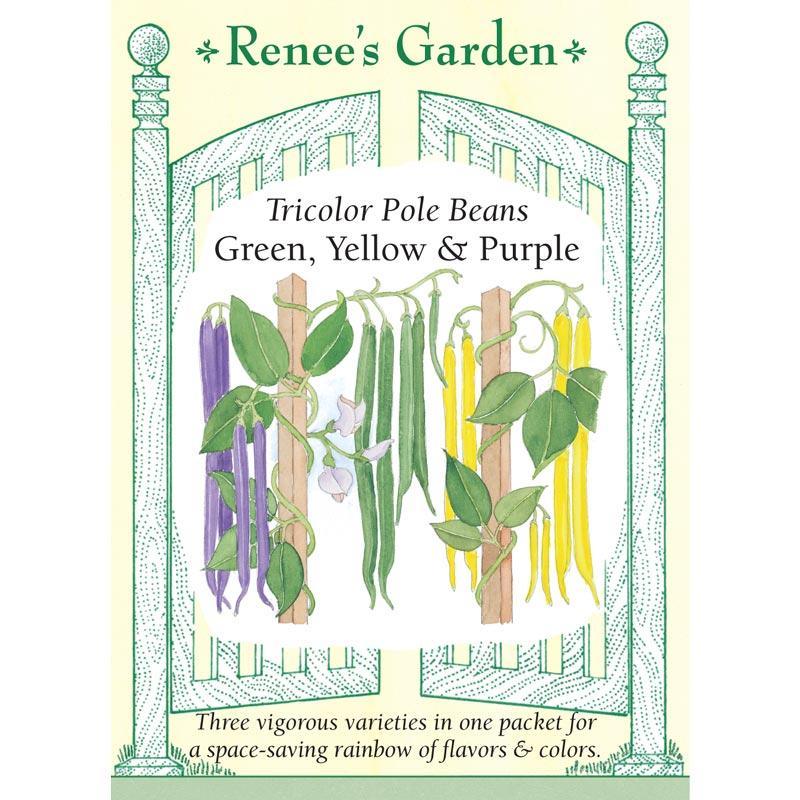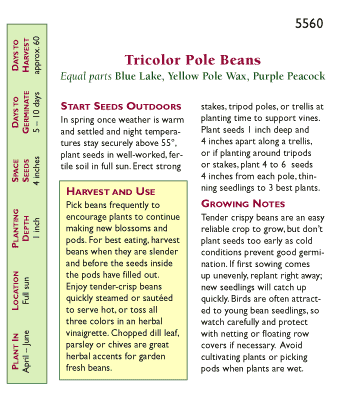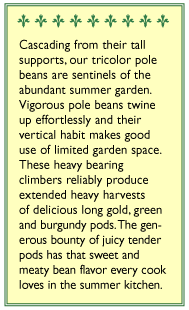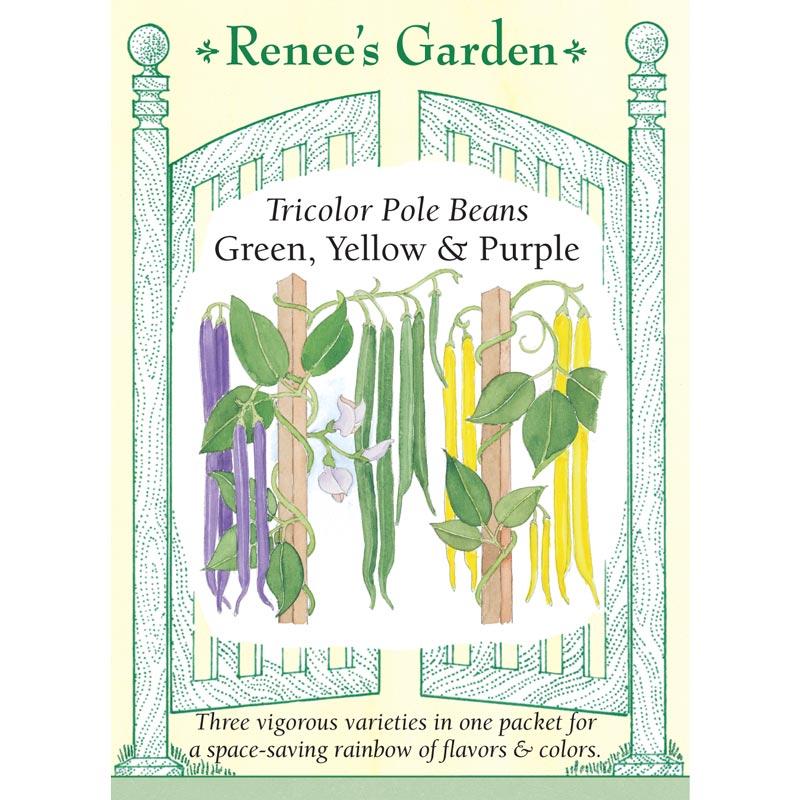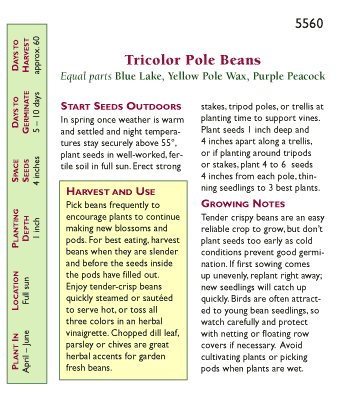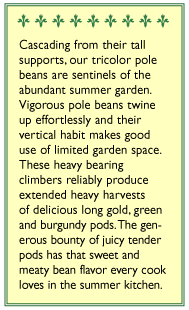Item Number: SNV5560
Green Yellow & Purple Tricolor Pole Bean Seed Mix
Green Yellow & Purple Tricolor Pole Bean Seed Mix
Space-Saving Vertical Bounty
Cascading from their tall supports, our tricolor pole beans are sentinels of the abundant summer garden. Vigorous pole beans twine up effortlessly and their vertical habit makes good use of limited garden space. These heavy bearing climbers reliably produce extended heavy harvests of delicious long, gold, green and burgundy pods. The generous bounty of juicy, tender pods has that sweet and meaty bean flavor every cook loves in the summer kitchen.
Growing Bean Pole Seeds and Exploring Various Varieties
Bean pole seeds are a popular choice among gardeners, offering a versatile and nutritious addition to any home garden. These climbing beans are known for their ability to grow vertically, making the most of limited garden space while producing an abundant harvest year after year. In this article, we will discuss the basics of growing pole beans and explore various bean varieties to help you choose the best ones for your garden.
Growing Pole Beans
Before delving into the various bean varieties, let's start with the basics of growing pole beans. Follow these steps for a successful bean pole garden:
- Selecting the Right Location: Choose a sunny location in your garden with well-drained soil. Pole beans thrive in full sunlight, so ensure they receive at least 6-8 hours of direct sunlight daily.
- Preparing the Soil: Prepare the soil by amending it with compost or well-rotted organic matter to improve its fertility and drainage. Beans are relatively forgiving when it comes to soil type, but they prefer a slightly acidic to neutral pH.
- Planting Pole Bean Seeds: Plant pole bean seeds directly in the garden bed after the last frost date in your region. Space the seeds about 4-6 inches apart and plant them in rows with 2-3 feet of space between rows. Make sure to plant them near a trellis, fence, or pole they can climb.
- Providing Support: As the bean plants grow, they will need support to climb. Set up trellises, bamboo stakes, or a bean pole structure to provide the necessary support for the vines.
- Watering and Care: Keep the soil consistently moist but not waterlogged. Avoid overhead watering, as it can promote diseases. Mulch around the base of the plants to help retain soil moisture and suppress weeds.
- Harvesting: Pole beans are typically ready for harvest 60-70 days after planting. Harvest the beans when they are young and tender, before the pods become tough and stringy. Regular harvesting encourages continuous production.
Bean Varieties
Now, let's explore some popular bean varieties that you can consider growing in your garden:
- Kentucky Wonder: This heirloom variety is known for its delicious, stringless pods and vigorous growth. Kentucky Wonder beans are a classic choice among pole bean enthusiasts, producing beans that are about 6-8 inches long.
- Blue Lake: Blue Lake beans are another favorite among gardeners. They are known for their crisp texture and rich flavor. These beans are well-suited for canning, freezing, or simply enjoying fresh from the garden.
- Scarlet Runner: Unlike green beans, scarlet runner beans are primarily grown for their ornamental value, featuring vibrant red flowers and attractive foliage. However, the young pods are also edible and have a slightly nutty flavor.
- Fortex: Fortex beans are prized for their extra-long, slender pods that can reach up to 11 inches in length. They have a sweet, crisp taste and are excellent for both fresh consumption and cooking.
- Rattlesnake: Rattlesnake beans are characterized by their distinctive purple streaks on the pods. They have a tender, flavorful taste and are often used in stir-fries and salads.
- Romano: Romano beans, also known as Italian flat beans, have broad, flat pods with a unique flavor and meaty texture. They are a favorite in Mediterranean cuisine and are delicious when sautéed with garlic and olive oil.
Growing pole beans can be a rewarding experience for gardeners, offering a space-efficient way to produce a bountiful harvest year after year. By choosing from the diverse range of bean varieties available, you can cater to your taste preferences and culinary needs while enjoying the benefits of homegrown, fresh produce. Remember to provide proper care and support to your bean plants, and you'll be rewarded with a season of delicious beans to savor and share.
Check Your Zone Compatibility:
Compatible with your zone.
Growing Zone for
,

Our Guarantee To You
Since 1976, we've served our customers at every stage of growing. Please contact us at any time. We are happy to support and assist you.
Description
Description
Cascading from their tall supports, our tricolor pole beans are sentinels of the abundant summer garden. Vigorous pole beans twine up effortlessly and their vertical habit makes good use of limited garden space. These heavy bearing climbers reliably produce extended heavy harvests of delicious long, gold, green and burgundy pods. The generous bounty of juicy, tender pods has that sweet and meaty bean flavor every cook loves in the summer kitchen.
Growing Bean Pole Seeds and Exploring Various Varieties
Bean pole seeds are a popular choice among gardeners, offering a versatile and nutritious addition to any home garden. These climbing beans are known for their ability to grow vertically, making the most of limited garden space while producing an abundant harvest year after year. In this article, we will discuss the basics of growing pole beans and explore various bean varieties to help you choose the best ones for your garden.
Growing Pole Beans
Before delving into the various bean varieties, let's start with the basics of growing pole beans. Follow these steps for a successful bean pole garden:
- Selecting the Right Location: Choose a sunny location in your garden with well-drained soil. Pole beans thrive in full sunlight, so ensure they receive at least 6-8 hours of direct sunlight daily.
- Preparing the Soil: Prepare the soil by amending it with compost or well-rotted organic matter to improve its fertility and drainage. Beans are relatively forgiving when it comes to soil type, but they prefer a slightly acidic to neutral pH.
- Planting Pole Bean Seeds: Plant pole bean seeds directly in the garden bed after the last frost date in your region. Space the seeds about 4-6 inches apart and plant them in rows with 2-3 feet of space between rows. Make sure to plant them near a trellis, fence, or pole they can climb.
- Providing Support: As the bean plants grow, they will need support to climb. Set up trellises, bamboo stakes, or a bean pole structure to provide the necessary support for the vines.
- Watering and Care: Keep the soil consistently moist but not waterlogged. Avoid overhead watering, as it can promote diseases. Mulch around the base of the plants to help retain soil moisture and suppress weeds.
- Harvesting: Pole beans are typically ready for harvest 60-70 days after planting. Harvest the beans when they are young and tender, before the pods become tough and stringy. Regular harvesting encourages continuous production.
Bean Varieties
Now, let's explore some popular bean varieties that you can consider growing in your garden:
- Kentucky Wonder: This heirloom variety is known for its delicious, stringless pods and vigorous growth. Kentucky Wonder beans are a classic choice among pole bean enthusiasts, producing beans that are about 6-8 inches long.
- Blue Lake: Blue Lake beans are another favorite among gardeners. They are known for their crisp texture and rich flavor. These beans are well-suited for canning, freezing, or simply enjoying fresh from the garden.
- Scarlet Runner: Unlike green beans, scarlet runner beans are primarily grown for their ornamental value, featuring vibrant red flowers and attractive foliage. However, the young pods are also edible and have a slightly nutty flavor.
- Fortex: Fortex beans are prized for their extra-long, slender pods that can reach up to 11 inches in length. They have a sweet, crisp taste and are excellent for both fresh consumption and cooking.
- Rattlesnake: Rattlesnake beans are characterized by their distinctive purple streaks on the pods. They have a tender, flavorful taste and are often used in stir-fries and salads.
- Romano: Romano beans, also known as Italian flat beans, have broad, flat pods with a unique flavor and meaty texture. They are a favorite in Mediterranean cuisine and are delicious when sautéed with garlic and olive oil.
Growing pole beans can be a rewarding experience for gardeners, offering a space-efficient way to produce a bountiful harvest year after year. By choosing from the diverse range of bean varieties available, you can cater to your taste preferences and culinary needs while enjoying the benefits of homegrown, fresh produce. Remember to provide proper care and support to your bean plants, and you'll be rewarded with a season of delicious beans to savor and share.
While Renee's Garden seeds are not all certified organic, they do not sell treated or GMO seeds and have signed the "Safe Seed Pledge.”
Shipping Information
Shipping Information
Shipping Weight: 0.01 lb
Dimensions: 4.5"L x 3.125"W x 0.1"H
Features
Features
- Open-Pollinated
Characteristics
Characteristics
Planting & Care
Planting & Care
Planting: In Spring, once weather is warm and settled and night temperatures stay securely above 55°F, plant seeds in well-worked, fertile soil in full sun. Erect strong stakes, tripod poles, or trellis at planting time to support vines. Plant seeds 1" deep and 4" apart along a trellis, or if planting around tripods or stakes, plant 4 - 6 seeds 4" from each pole, thinning seedlings to 3 best plants.
Growing:Tender, crispy beans are an easy and reliable crop to grow, but don't plant seeds too early as cold conditions prevent good germination. If first sowing comes up unevenly, replant right away; new seedlings will catch up quickly. Birds are often attracted to young bean seedlings, so watch carefully and protect with netting or floating row cover if necessary. Avoid cultivating plants or picking pods when plants are wet.
Harvest & Use: Pick beans frequently to encourage plants to continue making new blossoms and pods. For best eating, harvest beans when they are slender and before the seeds inside the pods have filled out. Enjoy tender-crisp beans quickly steamed or sautéed to serve hot, or toss all three colors in an herbal vinaigrette. Chopped dill leaf, parsley or chives are great herbal accents for garden fresh beans.
Useful Information
Useful Information
Guarantee
Guarantee
Share
